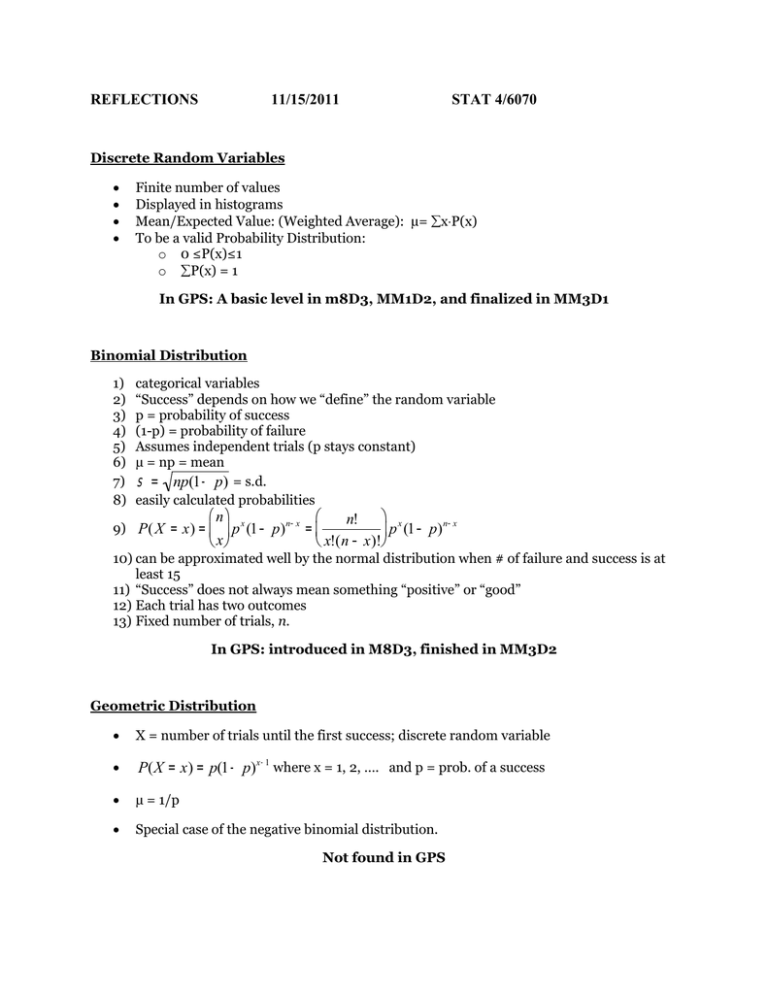REFLECTIONS 11/15/2011 STAT 4/6070
advertisement

REFLECTIONS 11/15/2011 STAT 4/6070 Discrete Random Variables Finite number of values Displayed in histograms Mean/Expected Value: (Weighted Average): µ= xP(x) To be a valid Probability Distribution: o 0 ≤P(x)≤1 o P(x) = 1 In GPS: A basic level in m8D3, MM1D2, and finalized in MM3D1 Binomial Distribution 1) 2) 3) 4) 5) 6) 7) 8) categorical variables “Success” depends on how we “define” the random variable p = probability of success (1-p) = probability of failure Assumes independent trials (p stays constant) µ = np = mean s = np(1- p) = s.d. easily calculated probabilities æ nö æ n! ö x n-x ÷ p (1- p) è x!(n - x)!ø 9) P( X = x) = ç ÷ p x (1- p) n-x = ç è xø 10) can be approximated well by the normal distribution when # of failure and success is at least 15 11) “Success” does not always mean something “positive” or “good” 12) Each trial has two outcomes 13) Fixed number of trials, n. In GPS: introduced in M8D3, finished in MM3D2 Geometric Distribution X = number of trials until the first success; discrete random variable P(X = x) = p(1- p)x-1 where x = 1, 2, …. and p = prob. of a success µ = 1/p Special case of the negative binomial distribution. Not found in GPS Normal Distribution (Continuous R. Variable) z-score probability Probability distribution symmetric, bell-shaped graph Mean and Standard deviation parameters Empirical Rule (Image from our textbook, p. 280) Standard Normal Distribution µ=0, =1 Cumulative Probability: (Image from textbook, p 282.) Continuous random variable has possible values that form an interval Probability is between 0 and 1. In GPS: MM3D2 taught along with Binomial. Adding/Subtracting Two Independent Random Variables The sum of the means = mean of total mx ± y = mx ± m y The square root of the sums of the squares of the standard deviations (of the parts) is the standard deviation of the total (or difference) s 2x + y = s 2x + s 2y s 2x- y = s 2x + s 2y In GPS: a slight link to MM1D2 Frequentist versus Bayesian Probability FREQUENTIST BAYESIAN Long run relative frequency is fixed and unknown never gets assigned probability Probability is evidence based – degree belief must be given a distribution has probability but no agreement on dist. I didn’t find this topic in GPS Confidence Interval for a Proportion Estimate margin of error sample proportion z (standard error of sample proportion) Contains a range of plausible values for the population proportion at a specified confidence level If using 95% confidence level, in repeated sampling, if we build an interval using the above procedure, we expect 95% of the intervals to capture the population proportion. In GPS: MM4d2 and MM4d3

